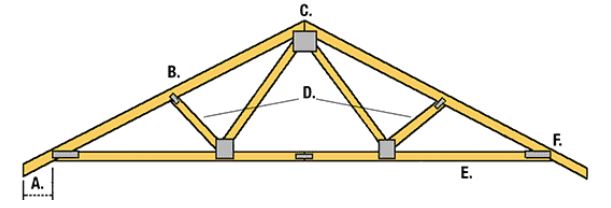
Trusses and rafters are two of the most common ways to build the pitched roof of a stick frame home and each method has its advantages and disadvantages. Choosing rafters or trusses for your home is a big decision, and one that you should try to learn a lot about before making.
So, should you use rafters or trusses in building your home? Trusses have become the standard method of building a roof because they are cheaper and easier to install. There are a few situations where it is better to use rafters, mainly building in remote locations, if you want more attic space or if you are building a small structure like a tiny house. Rafters and trusses perform about the same in terms of strength. The fact that trusses are built in an automated process has made it by far the most popular choice of homebuilders today.
When built correctly, both trusses and rafters will perform well as part of your home. If you want to learn some more about rafters and trusses and when you might want to choose one over the other, continue reading for some helpful information.
(Note: I got the two above images from designingbuildings.co.uk and menards.com.)
What Are Rafters?

You might think of rafters as the ribs of the roof. They are the boards that connect the ridge of the house with the walls of the house, and create a structure for the roof deck and the roofing to sit on. Ceiling joists connect the walls of the house together under the rafters.
The rafters and ceiling joists form a triangle, where the ceiling joists are the bottom of the triangle, the rafters are the sides of the triangle and the ridge beam is the top point of the triangle. Triangles are very strong and can support the weight of the roof.
Rafters are normally made from 2×10 or larger boards and are built on the construction site of a new house. They are not easy to construct, and because rafters are becoming less popular, it is also getting difficult to find framers with the skills to build them. Until about the 1960’s, almost all homes in the USA were built with rafters.
Rafters create a lot of space underneath them, so you can have a livable attic space above the main floor of the house. Alternatively, with rafters you have the opportunity to create high and impressive vaulted ceilings. In that case, you should use a “collar tie” to join the two sides of the rafters near the roof peak.
Sometimes rafters are used as an architectural feature of a house like in a cathedral ceiling with open rafters. They can also be concealed behind drywall or another wall material.
What Are Trusses?

While rafters use one large triangle to support the roof, trusses use a webbing of several triangles to support the roof.
Trusses are made from smaller pieces of wood than rafters, with many connection points to create a solid structure. The small pieces of wood are held together by metal truss connector plates, which were patented in 1955 and allowed trusses to become the choice of around 80% of home builders for roofs today.
It is possible to build trusses by hand, but in commercial construction they are always built in factories. It is also possible to purchase truss kits, which come with everything you need to build trusses, including engineering plans for building inspection.
You must know all of the specifications for your trusses to order them, then they can be assembled in the factory and then delivered to the construction site. If you have ever seen a semi-truck driving by with what looks like a bare top of a house as cargo, that was a delivery of trusses.
Larger trusses will require a crane to lift them onto the house and smaller trusses can be placed by hand. Trusses normally will come with instructions for installation from the manufacturer. Installing trusses is generally a simple task that almost anyone can do.
You can have a higher, vaulted ceiling by installing scissor trusses, but they won’t go all the way to the peak of the roof like rafters do. You can build an attic if you use an attic truss, but still there will be some dead space between the roof deck and the walls of the attic.
The Advantages Of Rafters
- Customizability – If you are building a custom home with a more interesting roof line, rafters are the way to go. Rafters give you more flexibility on the shape of the roof, as they can be cut and assembled in many ways to give your roof exactly the look you desire. With trusses being built in a mostly automated process, it can be harder to get a unique roof shape.
- Attic Space – Rafters are also the best choice if you want to have a living space in the attic of your home. It is easy to fit a master bedroom with a bathroom in a large home, or a smaller room like an office under the rafters. There can be less dead space with rafters than with trusses.
- Modularity – If you have any plans to make future modifications to the upper level of your home, rafters will allow you to more easily do that than trusses. Rafters can be modified in many ways, so if you think you might want to add a pop up roof in your attic someday to make more room for a bathroom, rafters will allow you to do that.
- The fact that trusses have such an intricate design with each piece depending on all of the other pieces means that even drilling a hole into a truss could have a negative impact and weaken the structure. Before making any modification to a truss, it is advised to consult an engineer to find the best way to do it while maintaining the structural integrity of the truss.
- Transportability – For a project that is in a remote location that does not have access to a paved road, rafters are probably the only option for you. Trusses usually need to be delivered on a semi truck, and if a semi truck can’t reach your property you can’t get trusses.
The Advantages Of Trusses
- Bigger Span – Trusses are capable of spanning greater distances than rafters, up to 60 feet, so they allow you to build a more open concept house. With trusses, you need less load bearing interior walls so you can have larger open spaces inside the home.
- Quality controlled – Being made in an indoor factory, trusses have more quality control and are more standardized. This ensures that the trusses will perform how they are supposed to and will support your roof in all conditions. Rafters are built by hand, and if you don’t have skilled framers building them there could be more chance for error.
- Faster Installation – After delivery, trusses are quick to install, usually taking one day or less of work. For many homes, the roof decking and sheathing will be installed the same day. This means that the interior of your home will be protected from the elements more quickly. Rafters can take an entire work week to install, and if it rains during that time the inside of your building could get wet.
- Use Less Lumber – Trusses are made from 2×4 lumber and can be spaced wider than a raftered roof, so you end up using less lumber with trusses than with rafters. If you want to use less lumber, and especially if lumber is scarce in your area, trusses would be the best choice for your home.
- Cheaper – Trusses have a higher upfront cost, but after you factor in the labor to construct rafters, trusses become the cheaper option. If you don’t have the skills to build rafters yourself, trusses are going to save you a lot of labor costs.
Which Are Stronger, Rafters Or Trusses?
When built properly, trusses and rafters are definitely strong enough to hold up your roof. They have been used for hundreds of years, and there are examples of both which have been standing for centuries.
Rafters and trusses are designed to carry a certain load, so they can be equal in strength. Trusses can achieve this equal strength with less material because they rely on their geometry for strength, rather than the strength of the materials used. You will need larger boards for rafters, which will be heavier, to achieve the same strength as you get from trusses.
How Long Does It Take To Deliver Trusses After Ordering?
The time it takes between when you order trusses and when they are delivered is called “lead time.” A typical lead time for trusses is from two to four weeks, depending on how busy the manufacturer is.
It is best to order trusses as far in advance as you are able to, and specify that you want them delivered at the time that you are ready to install them. That way they can go directly from the factory to being part of your home, with minimal exposure to the elements.
For rafters you don’t need a lead time because you only need to go to a lumber yard and buy the boards you will need and bring them to the construction site.
Insulation Differences Between Rafters and Trusses
It is thought that rafters are more straightforward to insulate, because you simply install batts between each rafter. For the best insulation performance, you should also use a layer of insulation above the rafters or inside of the rafters.
For trusses, insulation can give you more to think about. With a flat ceiling, you can use blown-in insulation. For scissor trusses blown in insulation might not be as effective because of the slopes on the vaulted ceiling and the blown in insulation’s tendency to settle. You might have to work out a plan with an insulation installer to get the best results in insulating scissor trusses.
Rafters For A Small Building
If you are building a tiny home or shed, it might make most sense to build rafters. Especially if you are building something that doesn’t require permits, it just might be more simple to build rafters.
One nice thing about trusses is that they come engineered and will be easy to get approved by inspectors. If you don’t need to worry about permits and inspections, rafters might be the easier way to build.

